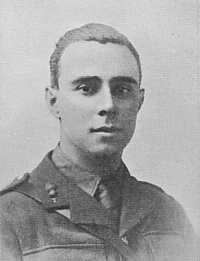
ALFRED HENRY GOODBARNE CHATTERTON
To lose any child during the Great War would have been a terrible loss to bear, but when it is your only child, the pain must last for ever. This was the case for Samuel and Sarah Chatterton who lost their son Alfred Henry to the war in the Middle East.
Samuel had been born at Poplar in London in 1863 to parents Henry and Sarah Chatterton. By the time he was 18 years old he was practising the trade which would occupy him for his entire working life - that of a blacksmith. Samuel met Sarah Mary Ann Hawkins in Poplar and married her there in 1886. Shortly afterwards the couple moved to Portsmouth, where, presumably Samuel thought there would be better job opportunities. He quickly found work at Gunwharf in Portsea and a house at 16 Stansted Road in Southsea.
The couple's first and only child was born in 1888. He was christened Alfred Henry Goodbarne Chatterton but in the 1891 census he appears as Henry. In 1899 Alfred Henry began attending the Higher Grade School on Victoria Road North in Southsea and continued there until 1902 after which he secured an apprenticeship in H.M. Dockyard in open competition. Eight years later, he relinquished this post and, in order to prepare for the ministry of the Church, joined St. Edmund Hall, Oxford, as an undergraduate.
The 1911 census catches him during the Easter vacation at home with his parents who were by then living at 9 Greyshott Road, close to Goldsmith Avenue. Samuel had by that time consolidated his position at Gunwharf where he was qualified as a Master Artificer.

Although Alfred Henry did not enlist at the outbreak of the Great War it wasn't long before he felt it was his duty to do so and in August, 1915, was gazetted a 2nd Lieutenant to the 3rd Wessex Royal Field Artillery. Whilst waiting for his unit to be assigned orders he took the opportunity to get married to Fanny Mullinger early in 1916. She was born in Portsea in 1881 the daughter of Royal Naval Engineer and was living at 16 Pelham Road with her mother at the 1911 census.
With the 215th Brigade Alfred Henry proceeded to India in May 1916, and in October moved forward again to join the British forces in Mesopotamia. In June, 1917, he was promoted to a full lieutenancy and given a staff appointment.
July brought days of record high temperatures, ranging from 120º to 124º in the shade, and many officers and men died as a result. Fever followed by heat stroke overtook Lieut. Chatterton and, in spite of the efforts of the hospital staff, he died on 21st July, 1917. He was buried at Baghdad the next day.
In a letter to the widow, the Officer Commanding the Brigade says: "Your husband was held in very high esteem by all ranks. In the mess he was very popular and on parade he was held in high respect as a hard-working and capable Officer." Some words of the Adjutant show the sacrifice he was prepared to make for the conscientious fulfilment of duty:— "My duties took me away for a week, leaving him with complete confidence in charge, and it was through his sticking to his post and refusing 'to go sick' on the third day that probably was his undoing."
FURTHER INFORMATION
The photograph above was taken from a WW1 memorial booklet published by Southern Grammar School. Extracts also appear above.
The Commonwealth War Graves Commission (CWGC) lists Lieutenant AHG Chatterton, Royal Field Artillery, died on 21/07/1917. Buried in Baghdad (North Gate) War Cemetery (Grave Ref: XV.A.4.).
Alfred Chatterton is remembered on the Southern Grammar School WW1 Memorial, the WW1 Memorial at St. Peter's Church and on the Cenotaph. He is not listed in the 'National Roll of the Great War'.
Tim Backhouse
June 2014